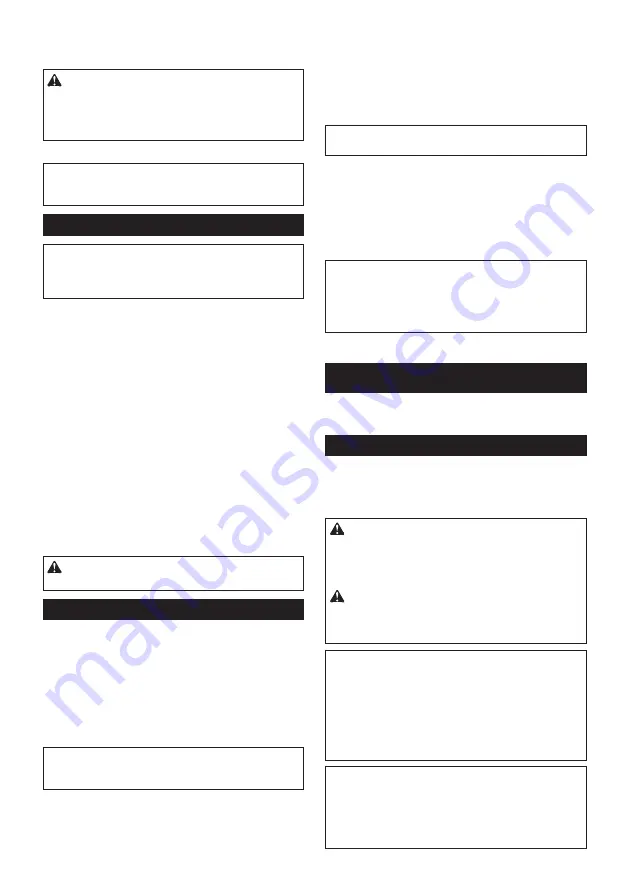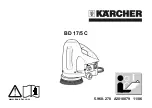
20 ENGLISH
3.
Install the cap, brushroll, and bottom plate in
reverse order.
►
Fig.39
CAUTION:
Place the bottom plate back in the
position securely until the two lock levers click in
place.
If the appliance is operated without the bottom
plate, the brushroll may come off, resulting in injury.
►
Fig.40:
1.
Bottom plate
2.
Lock lever
NOTICE:
Always attach the brushroll.
Operating
the appliance without the brushroll results in poor
dust collecting.
How to clear the clog
NOTICE:
Do not operate the appliance with the
intake flow path clogged.
Continuous use with the
intake flow path clogged results in reduced suction
power.
1.
Remove the bottom plate, and then remove the
brushroll.
2.
Remove the aluminum pipe from the appliance
and from the hose.
3.
Turn the hose counterclockwise, and then remove
the hose from the appliance.
4.
Remove the suction hose by pulling the tab.
►
Fig.41:
1.
Bottom plate
2.
Brushroll
3.
Aluminum
pipe
4.
Hose
5.
Suction hose
6.
Tab
5.
Inspect the intake flow path of air for the inside of
the aluminum pipe and the hose, and the suction hose.
Remove the debris from inside of them.
6.
Align the tongue of the suction hose with the
groove in the housing and slip it into place.
►
Fig.42:
1.
Tongue
2.
Groove
7.
Install the hose, aluminum pipe, brushroll, and
bottom plate.
CAUTION:
Install the hose, pipe firmly.
Otherwise dust leakage may occur and cause injury.
Dust bag
Optional accessory
The dust bag can be used repeatedly by cleaning it out.
Installing and removing dust bag
The procedure of installing and removing the dust bag
is same as the filter bag. Please refer to the section for
installing the filter bag and removing the filter bag.
►
Fig.43:
1.
Dust bag
2.
Rubber cap
NOTICE:
When installing the dust bag, open the
rubber cap first. Insert the dust bag with the rub
-
ber cap behind.
Emptying dust bag
1.
Close the rubber cap to prevent dust from floating out.
2.
Open the bag mouth by pulling the fastener out.
3.
Empty the dust bag of its contents, tapping it
lightly so as to remove particles adhering to the insides.
►
Fig.44:
1.
Dust bag
2.
Rubber cap
3.
Fastener
NOTICE:
Empty the dust bag frequently.
Too
much dust will tear the bag easily.
Cleaning the dust bag
Regularly clean the dust bag with soap and water. Turn
the dust bag inside out and remove the sticky dust.
Wash lightly by hand and rinse well with water. Dry
completely before installing to the vacuum cleaner.
►
Fig.45
NOTICE:
Wet dust bag lowers the vacuuming
performance as well as the life of the motor.
NOTICE:
When mounting the fastener on the
dust bag, make sure that the bag mouth is
securely closed.
CYCLONE ATTACHMENT
Optional accessory
►
Fig.46:
1.
Cyclone attachment
About the cyclone attachment
Using the cleaner with the cyclone attachment installed
reduces the amount of dust that enters the filter bag,
which helps to prevent the suction force from weaken-
ing. In addition, cleaning after use is also simple.
CAUTION:
Always be sure that the tool is
switched off and the battery cartridge is removed
before carrying out any work on the tool.
If the
battery cartridge is left inserted, the cleaner may start
unexpectedly and result in injury.
CAUTION:
Clean the mesh filter of the cyclone
attachment and the filter bag of the cleaner unit
when they become clogged.
Continued use in the
clogged condition may result in heating or smoke.
NOTICE:
When the cyclone attachment is
attached, do not use the cyclone attachment in
the horizontal or upward facing condition.
Doing
so may cause the mesh filter to become clogged.
NOTICE:
Always use the cleaner with the fil
-
ter bag installed, even when using the cyclone
attachment.
Using the cleaner without the filter bag
installed may result in a motor malfunction.
NOTE:
Check that the cyclone attachment, cleaner,
and straight pipe are locked properly before use.
NOTE:
Empty the dust case of the cyclone attach-
ment and the filter bag of the cleaner when dust has
accumulated. Continued use will result in weakened
suction force.
Summary of Contents for VC010G
Page 3: ...3 1 2 Fig 6 1 2 Fig 7 Fig 8 2 4 3 1 Fig 9 1 2 Fig 10 1 Fig 11 Fig 12 1 Fig 13...
Page 4: ...4 1 Fig 14 1 2 Fig 15 1 2 3 4 5 Fig 16 Fig 17 1 2 Fig 18 1 Fig 19 1 Fig 20 Fig 21...
Page 5: ...5 Fig 22 1 A B C Fig 23 Fig 24 Fig 25 Fig 26...
Page 6: ...6 1 Fig 27 1 Fig 28 1 Fig 29 1 Fig 30 Fig 31 Fig 32 Fig 33...
Page 7: ...7 Fig 34 1 Fig 35 1 2 3 Fig 36 1 2 Fig 37 1 Fig 38 Fig 39...
Page 8: ...8 1 2 Fig 40 5 6 1 2 3 4 Fig 41 1 2 Fig 42 1 2 Fig 43 1 2 3 Fig 44 Fig 45...
Page 9: ...9 1 Fig 46 1 2 4 3 Fig 47 1 2 3 4 5 6 Fig 48 Fig 49 1 2 3 4 Fig 50 1 2 Fig 51 1 2 Fig 52...
Page 10: ...10 1 2 Fig 53 1 2 3 Fig 54...
Page 107: ...107 1 2 3 4 5 6 7 8 9 10 11 12 13 14 15 16 17 18 19 20 21 22 23 24 25 26 27 28...
Page 108: ...108 29 30 31 32 33 1 2 3 4 5 6 130 C 7 1 1 2 3 2 3 4 5 1 2 3 6 50 C 7 8 9...
Page 110: ...110 1 2 2 1 2 3 3 1 4 1 2 5 6 1 2...
Page 111: ...111 1 7 1 2 2 8 3 9 1 2 3 4 10 1 2 4 11 1 5 12 6 13 1 14 1 60 60...
Page 112: ...112 15 1 2 75 100 50 75 25 50 0 25 16 1 2 3 4 5 17 50 100 20 50 0 20...
Page 113: ...113 18 1 2 1 2 3 19 1 90 20 1 21 22 5 A B C 23 1 24 25...
Page 114: ...114 1 2 26 Makita 27 1 28 1 29 1 30 1 31 32 Makita Makita 33 34 HEPA...
Page 116: ...116 1 2 3 44 1 2 3 45 46 1 1 47 1 2 3 4 2 48 1 2 3 4 5 6 3 49...
Page 117: ...117 1 50 1 2 3 4 2 3 51 1 2 52 1 2 1 53 1 2 2 3 54 1 2 3...
Page 118: ...118 Makita Makita HEPA HEPA...
Page 119: ...119 Makita Makita HEPA Makita...














































